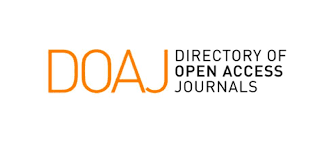Effect of X-ray Tube Voltage Variation on Signal to Noise Ratio (SNR) by Application of Anode Heel Effect using Stepwedge
Abstract
It has been conducted research to determine the effect of X-ray tube voltage variation (kV) on Signal to Noise Ratio (SNR) values by applying the Anode Heel Effect using stepwedge with the addition of 1.5 mm thickness each step. The stepwedge used was 1.5-31.5 mm. The X-ray tube voltage variations used were 40, 50, 60, 70, 80, and 90 kV. Analysis of the effect of X-ray tube voltage variation on SNR values is determined using IMB SPSS Statistics 26 with a simple regression test. The test results showed that variations in X-ray tube voltage affect SNR values, where the greater the variation in X-ray tube voltage then the SNR value would get smaller. The optimal SNR value of 72.685 was obtained at a tube tension of 40 kV and a stepwedge thickness of 27.0 mm.
Downloads
References
[2] Alfiati, Studi Efek Heel pada Film Radiografi [Skripsi Fisika Medik]. Makasar: Konsentrasi Fisika Medik Jurusan Fisika Medik Fakultas Matematika dan Ilmu Pengetahuan Alam Universitas Hasanuddin, 2013.
[3] S. Litasova, E. Hidayanto, M. Azam, Pengaruh Ketebalan dan Kombinasi Jenis Filter terhadap Nilai Entrance Skin Exposure (ESE) Menggunakan Faktor Eksposi Pemeriksaan Kepala, Youngster Physics Journal, vol. 07, no. 2, 2018, pp 67-75.
[4] T. L. Fauber, Radiographic Imaging and Exposure Fourth Edition, Associate Professor and Radiography Program Director, Department of Radiation Sciences, School of Allied Health Professions, Virginia Commonwealth University, Richmond, Virginia, 2012.
[5] C. Louk, dan G. B. Suparta, Pengukuran Kualitas Sistem Pencitraan Radigrafi Digital Sinar-X, Journal of Mathematics and Natural Sciences BIMIPA, vol. 24, no. 2, 2014, pp 149-166.
[6] Z. A. Afani, N. N. Rupiasih, Pengolahan Film Radiografi Secara Otomatis menggunakan Automatic X-Ray Film Processor Model JP-33, Buletin Fisika Journal, vol. 18, no. 2, 2017, pp 53-57.
[7] H. Dabukke, Pengujian Iluminasi, Kolimasi, Ketegaklurusan dan Kualitas Berkas Pesawat Sinar-X Radiografi Umum dengan Radiografi Mobile [Tesis]. Medan: Program Studi Magister (S2) Fisika Fakultas Matematika dan Ilmu Pengetahuan Alam Universitas Sumatra Utara, 2018.
[8] M. Ferryadi, Penentuan Ketepatan Titik Pusat Berkas Sinar dari Sudut Berkas Pada Pesawat General X-Ray Sebagai Parameter Kualitas Kontrol [Skripsi]. Medan: Departemen Fisika Fakultas Matematika dan Ilmu Pengetahuan Alam Universitas Sumatra Utara, 2017.
[9] R. Aryawijayanti, Analitisi Dampak Radiasi Sinar-X pada Mencit Melalui Pemetaan Dosis Radiasi di Laboratorium Fisika Medik [Skripsi]. Semarang: Jurusan Fisika Fakultas Matematika dan Ilmu Pengetahuan Alam Universitas Negeri Semarang, 2015.
[10] R. Bourne, Fundamentals of Digital Imaging in Medicine, Springer London Dordrecht Heidelberg, New York, 2009.
[11] A. Sudin, Z. Muhlisin, H. Widiyandari, Studi Pengaruh Ukuran Pixel Imaging Plate Terhadap Kualitas Citra Radiograf, Jurnal Berkala Fisika, vol. 18, no. 3, 2015, pp 89-94.
[12] F. Anita, D. A. Tunggadewi, Uji Banding Citra Film terhadap Computed Radiography (CR), Jurnal Ilmiah GIGA, vol. 23, no. 1, 2020, pp 20-26.
[13] E. Sparzinanda, Nehru, Nurhidayah, Pengaruh Faktor Eksposi terhadap Kualitas Citra Radiografi, Journal Online of Physics, vol. 3, no. 1, 2017, pp 14-22.










